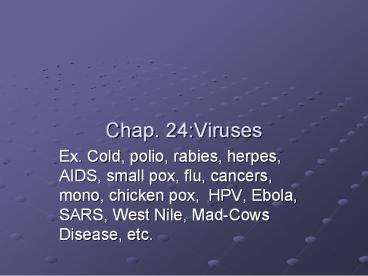Chap. 24:Viruses - PowerPoint PPT Presentation
1 / 9
Title:
Chap. 24:Viruses
Description:
Chap. 24:Viruses Ex. Cold, polio, rabies, herpes, AIDS, small pox, flu, cancers, mono, chicken pox, HPV, Ebola, SARS, West Nile, Mad-Cows Disease, etc. – PowerPoint PPT presentation
Number of Views:112
Avg rating:3.0/5.0
Title: Chap. 24:Viruses
1
Chap. 24Viruses
- Ex. Cold, polio, rabies, herpes, AIDS, small pox,
flu, cancers, mono, chicken pox, HPV, Ebola,
SARS, West Nile, Mad-Cows Disease, etc.
2
I. Terminology
- Virology study of viruses
- Virulent when a virus causes a disease
- Temperate when a virus doesnt cause disease
right away (AIDS, cancer) - Obligate intracellular parasite (virus) must
use a host for reproducing - Nanometer (nm) measurement for virus. 4000 can
fit within a typed o
3
- Viroid smaller than a virus contains only a
single strand of RNA
- Prion contains about 250 amino acids no
nucleic acid. Causes long term diseases like
Kuru. - Bacteriophage virus that attacks bacteria (also
called phages) - Oncogenes genes that cause abnormal cell growth
(tumors, aka cancer) - II. Structure
- - classified by either having DNA or RNA not
by binomial nomenclature.
4
-- RNA viruses contain reverse transcriptase an
enzyme that changes RNA to DNA called
retroviruses.
5
III. Viral Cycles
- 1. Lysogenic Cycles
- a. Tail fibers attach to cell
- b. Nucleic acid injected into host
- c. Nucleic acid attaches to host nucleic acid
to become a prophage - d. Doesnt cause harm immediately but at some
point it can become the lytic cycle. - e. Causes transduction (spreading of new DNA to
another cell) ex. Cancers,cold sores,shingles,
AIDS
6
2. Lytic Cycle immediate taking over of a host
cell.
- Attachment virus attaches tail fibers down onto
host cell membrane. - Entry DNA/RNA is injected into cell.
- Replication viral DNA/RNA tells host cell to
make more viruses - Assembly making of more viruses
- Lysis (release) host cell ruptures and releases
all viruses to go and infect new cells. - -- interferon chemical released by host cell
upon rupture to signal neighboring cells of virus
7
IV. Transmitting of viruses
- Vector organism that transmits a virus
usually an arthropod (insect) ex. Tick, mosquito,
flea - Viral reservoir place where virus originated
- --- viruses are transmitted by air, exchange
of body fluids, direct contact, water
8
A. Viral Control
- 1. vaccination given inactivated (dead or
diluted amount) or attenuated (genetically
altered) virus. - ---- Result Antibodies made by body to
recognize and destroy virus - 2. Antiviral drugs drugs that interfere with
viral making. Ex. AZT for AIDS
9
Antibiotics do not work on viruses because
they are made to target the cell processes of a
bacteria
- Pandemic when a disease spreads across the
world. Ex. AIDS - Endemic disease isolated to a specifc region.
Ex. Ebola - Epidemic rapid spreading of a disease and
affecting many. Ex. Influenza 1918































